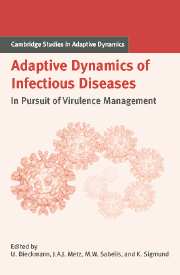Book contents
- Frontmatter
- Contents
- Contributing Authors
- List of Boxes
- Notational Standards
- 1 Introduction
- A Setting the Stage
- B Host Population Structure
- C Within-Host Interactions
- D Pathogen–Host Coevolution
- E Multilevel Selection
- F Vaccines and Drugs
- Introduction to Part F
- 23 Managing Antibiotic Resistance: What Models Tell Us?
- 24 Evolution of Vaccine-resistant Strains of Infectious Agents
- 25 Pathogen Evolution: The Case of Malaria
- 26 Vaccination and Serotype Replacement
- G Perspectives for Virulence Management
- References
- Index
- International Institute for Applied Systems Analysis
26 - Vaccination and Serotype Replacement
Published online by Cambridge University Press: 15 January 2010
- Frontmatter
- Contents
- Contributing Authors
- List of Boxes
- Notational Standards
- 1 Introduction
- A Setting the Stage
- B Host Population Structure
- C Within-Host Interactions
- D Pathogen–Host Coevolution
- E Multilevel Selection
- F Vaccines and Drugs
- Introduction to Part F
- 23 Managing Antibiotic Resistance: What Models Tell Us?
- 24 Evolution of Vaccine-resistant Strains of Infectious Agents
- 25 Pathogen Evolution: The Case of Malaria
- 26 Vaccination and Serotype Replacement
- G Perspectives for Virulence Management
- References
- Index
- International Institute for Applied Systems Analysis
Summary
Introduction
Vaccination has been an undisputed success in the control of many infectious diseases, both viral and bacterial. In recent decades, researchers have attempted to extend these successes to the development of vaccines against a variety of other infectious agents, ranging from long-standing public health threats like typhoid, gonorrhea, and malaria, to newly emerging or newly discovered organisms, such as human immunodeficiency virus (HIV) and hepatitis B virus. While some of these vaccine development efforts have succeeded quite rapidly – the hepatitis B vaccine is a good example – many have not yet produced highly effective vaccines. The presence of substantial antigenic diversity is a common feature that characterizes many of the infections for which vaccines have proved elusive. This diversity can take either, or both, of two forms. Within a single infected host, the expression of particular antigens may change during the course of an infection by a variety of mechanisms, including intragenomic recombination, phase variation through changes in the lengths of oligonucleotide repeats, and simple mutation. This process of antigenic variation may disrupt antigen-specific immune responses, with important consequences for the maintenance of infection and pathogen virulence. Antigenic diversity can also occur at the population level; in this case, the pathogens of a particular species circulating in the host population are characterized by polymorphism in one or more antigens. Each of these forms of polymorphism may increase the number of antigenic variants that a vaccine must “cover” to give strong protection, thereby increasing the difficulty of vaccine development.
- Type
- Chapter
- Information
- Adaptive Dynamics of Infectious DiseasesIn Pursuit of Virulence Management, pp. 362 - 374Publisher: Cambridge University PressPrint publication year: 2002
- 6
- Cited by



